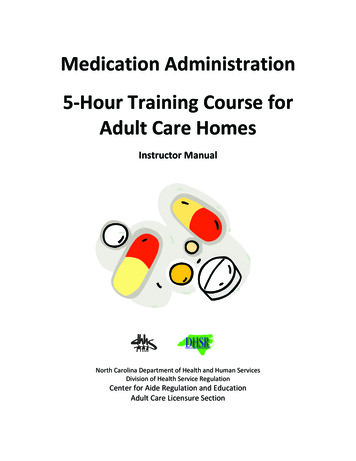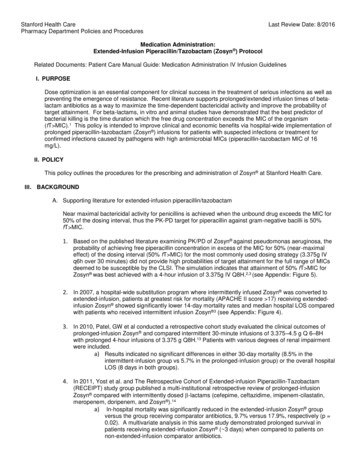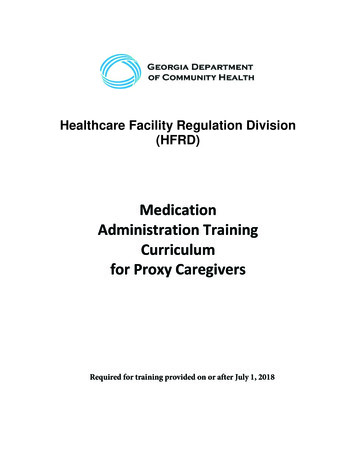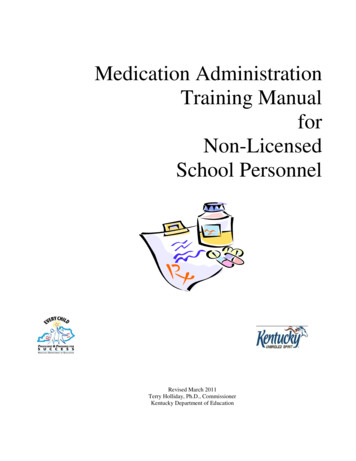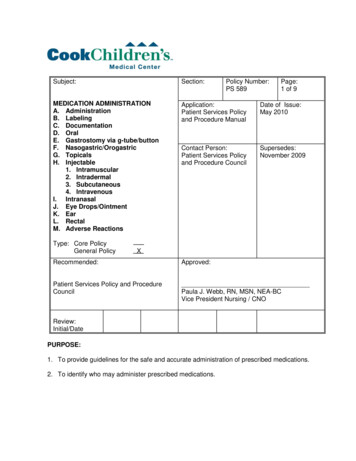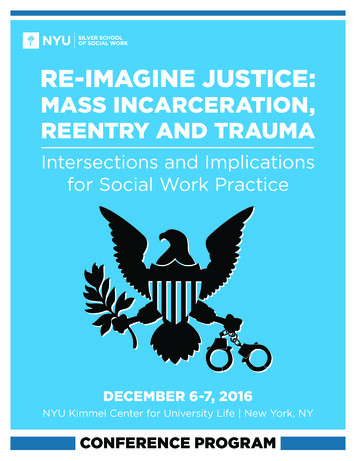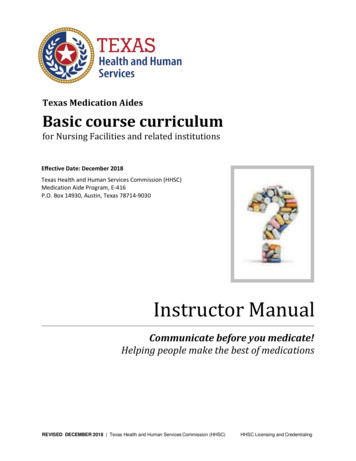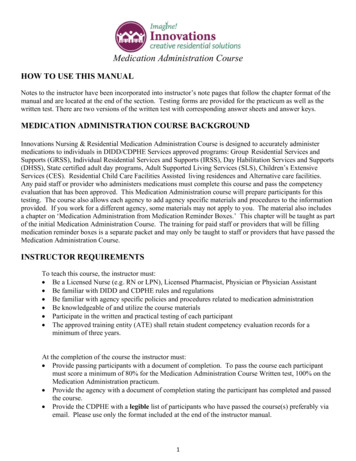
Transcription
Medication Administration CourseHOW TO USE THIS MANUALNotes to the instructor have been incorporated into instructor’s note pages that follow the chapter format of themanual and are located at the end of the section. Testing forms are provided for the practicum as well as thewritten test. There are two versions of the written test with corresponding answer sheets and answer keys.MEDICATION ADMINISTRATION COURSE BACKGROUNDInnovations Nursing & Residential Medication Administration Course is designed to accurately administermedications to individuals in DIDD/CDPHE Services approved programs: Group Residential Services andSupports (GRSS), Individual Residential Services and Supports (IRSS), Day Habilitation Services and Supports(DHSS), State certified adult day programs, Adult Supported Living Services (SLS), Children’s ExtensiveServices (CES). Residential Child Care Facilities Assisted living residences and Alternative care facilities.Any paid staff or provider who administers medications must complete this course and pass the competencyevaluation that has been approved. This Medication Administration course will prepare participants for thistesting. The course also allows each agency to add agency specific materials and procedures to the informationprovided. If you work for a different agency, some materials may not apply to you. The material also includesa chapter on ‘Medication Administration from Medication Reminder Boxes.’ This chapter will be taught as partof the initial Medication Administration Course. The training for paid staff or providers that will be fillingmedication reminder boxes is a separate packet and may only be taught to staff or providers that have passed theMedication Administration Course.INSTRUCTOR REQUIREMENTSTo teach this course, the instructor must: Be a Licensed Nurse (e.g. RN or LPN), Licensed Pharmacist, Physician or Physician Assistant Be familiar with DIDD and CDPHE rules and regulations Be familiar with agency specific policies and procedures related to medication administration Be knowledgeable of and utilize the course materials Participate in the written and practical testing of each participant The approved training entity (ATE) shall retain student competency evaluation records for aminimum of three years.At the completion of the course the instructor must: Provide passing participants with a document of completion. To pass the course each participantmust score a minimum of 80% for the Medication Administration Course Written test, 100% on theMedication Administration practicum. Provide the agency with a document of completion stating the participant has completed and passedthe course. Provide the CDPHE with a legible list of participants who have passed the course(s) preferably viaemail. Please use only the format included at the end of the instructor manual.1
COURSE MATERIALSMedication Administration Course materials include the following: Instructor’s Manual, which includes:o Testing materialso Participant completion formso Forms required by CDPHE for submitting names of participants who have passed the course.o Reference materials Student Manual, which includes:o Reading materialso Review questions Course materials to be provided by each agency/nurse include:o Copies of the student manual for each participanto Agency specific formso Agency specific policies and procedureso Practicum materialsRECOMMENDED CLASS STRUCTUREIt is recommended that at a minimum the following structure be followed when teaching this course to first timeparticipants. The average amount of time is listed in parenthesis. The classroom instruction time is to be basedon the number of participants and the learning styles of participants, instructors may use their discretion inregard to time frames and what portions of the course may be required for those individuals who are not firsttime participants or who are retaking the course for whatever reason (e.g. agency training requirements,individual actions, etc.). Classroom instruction to review course manual and agency specific material with qualifiedinstructor. (5) HoursPracticum and written testing with qualified instructor. (2-3 hours). Copies of written tests must becollected by instructor and NOT given out to students as study guides.2
IntroductionCourse Objectives To accurately administer medications to individuals in DIDD/CDPHE Services approved programs:Group Residential Services and Supports (GRSS), Individual Residential Services and Supports (IRSS),Day Habilitation Services and Supports (DHSS), State certified adult day programs, Adult SupportedLiving Services (SLS), Children’s Extensive Services (CES). Residential Child Care Facilities, Assistedliving residences, and Alternative care facilities. To safely administer medications according to written physician or other authorized practitioner orders. To maintain proper documentation of the administration of both prescription and non-prescriptionmedications. To use the proper techniques when administering medications by the various routes -ingestion,application, inhalation, insertion. To comprehend and be able to demonstrate the following: Important guidelines of medication administration Use and forms of drugs Medication orders Documentation including controlled medication documentation and count Seven “Rights” of medication administration Medication Administration Procedures Medication errors Medication storage Rules and regulations related to psychotropic medications Medication reminder box (MRB) guidelinesThe minimum passing score of this course written test is 80% to be considered as a Qualified MedicationAdministration Person (QMAP).Cautions:This course does NOT lead to certification or licensure to administer medications.QMAPs are NOT trained or authorized to make any medical or psychological judgement, assessment, orevaluation of the individual being assisted.QMAPs may ONLY administer medications according to the written physician or other authorizedpractitioner order by the following routes: Oral Sublingual Topical Eye drops or ointment Ear drops Nasal Transdermal Inhaled Rectal and vaginal QMAPs MAY NOT take phone orders for any medications including changes or discontinuation.3
FOR THIS COURSE MEDICATION ADMINISTRATION IS: As defined by law: ‘Assisting an individual in the ingestion, application, inhalation, or using universalprecautions, rectal or vaginal insertion of medication including prescription and non-prescription drugsaccording to the written or printed directions of a licensed physician or other authorized practitioner andmaking a written record thereof with regard to each medication administered, including the time andamount taken.’ [25-1.5-301(1)C.R.S.] Accurately and safely administering medications from medication reminder boxes (MRB) withoversight from a licensed individual (nurse or pharmacist) or Qualified Manager. Filling of medication Reminder Boxes with oversight by a Qualified Manager or Licensed individual(nurse or pharmacist). REQUIRES SEPARATE AND SPECIALIZED TRAINING Administering medications through a Gastrostomy Tube – EXTRA TRAINING ANDOBSERVATIONS ARE REQUIRED IN ORDER TO ADMINISTER ANYTHING THROUGH AG-TUBE (MUST ALSO MEET REQUIREMENTS FOR GASTROSTOMY SERVICES PRIOR TOADMINISTERING ANY MEDICATION, NUTRIENT OR LIQUID THROUGH A GASTROSTOMYTUBE!).SCOPE OF PRACTICE:The qualified medication administration Person (QMAP) is an individual who has successfullycompleted the medication administration course provided by Innovations Nursing & Residential Servicesapproved training entity.A QMAP is permitted to administer medications via oral, sublingual, ear, eye, topical, nasal, inhalant,rectal and vaginal routes. Gastrostomy tube medication administration may be done ONLY after additionalapproved training and under supervision of licensed nurse.A QMAP is permitted to administer medications in the following authorized settings; assisted livingresidences, adult foster care facilities, alternative care facilities, residential care facilities, secure residentialtreatment centers, state certified adult day programs and program approved service agencies for people withintellectual and developmental disabilities.As a QMAP and individual providing support to vulnerable adults, you are required to (to the best ofyour ability) report any suspicions regarding abuse, neglect or misappropriate of an individual’s property.Adults with intellectual and developmental disabilities are at risk for mistreatment, abuse, neglect, andexploitation, (M.A.N.E.) due to their lack of ability in interpreting social cues, inability to report problems orconcerns, inability to understand self-safety measures and more. The definitions (M.A.N.E.) will be reviewedduring agency orientation. If you suspect that abuse, neglect, mistreatment or theft is occurring you need toreport it to your supervisor. As you are working you need to be aware of what your co-workers are doing.Knowledge of what constitutes abuse, neglect, or mistreatment will help you prevent such occurrences.Substantiated allegations for M.A.N.E. or misappropriation will be reported to the proper authorities such as thepolice and the state.4
CAUTIONS: This is NOT a course that leads to certification or licensure to administer medications. If you havepassed this course you are considered QUALIFIED to administer medications, a Qualified MedicationAdministration Personnel (QMAP). Individuals successfully completing this course are NOT trained or authorized to make any type ofmedical or psychological judgment, assessment or evaluation of the individual being assisted. QMAPs may ONLY administer medications by the following routes: oral, sublingual, topical, eyedrops/ointments, eardrops, nasal, transdermal, inhaled, rectal or vaginal. Completion of this course does NOT allow administration or monitoring of medications by injection, orperforming fingers pricks for glucose testing. QMAPs MAY NOT administer any medication other than what the physician or other authorizedpractitioner (e.g. dentist, physician assistant, nurse practitioner, podiatrist, psychiatrist) has prescribed inwriting. QMAPs MAY NOT take phone orders for any medications including changes in medications or orders.REMEMBER: WHENADMINISTERINGMEDICATION,YOUARE RESPONSIBLE FORYOUR ACTIONS!5
Chapter 1Universal PrecautionsUniversal Precautions are steps designed to protect one’s self and others from infection if there is thepossibility of contact with anyone’s blood and/or bodily fluid.Using medical asepsis and universal precautions for infection controlPerformance Objectives Explain how infections can be transmitted from one individual to another Demonstrate proper hand washing techniques Demonstrate proper use of gloves Review facility Infection Control Plan or policies Identify when hands should be washed Identify when gloves should be worn Identify what to do if exposure to blood and body fluids occursOutlineA. How infections occur Pathogen Reservoir Portal of exit Transmission Portal of entry HostB. Use of medical asepsis Common daily practices Hand washing routine and use of hand sanitizer Additional procedures including Universal PrecautionsActivities Explain the rationale for close observance of infection control Explain how pathogens are transmitted from one individual or place to another Explain the Infection Control Policy for your facility Explain the importance of hand washing Demonstrate good hand washing technique Explain situations where gloves should be worn Demonstrate proper use and disposal of gloves Discuss disposition of contaminated equipment, linens Discuss what to do if exposure to blood or body fluids occurs Discuss use of hand sanitizersEvaluation Trainee must explain the need for Infection control practices and facility policy Trainee must describe how infections are spread Identify practices that prevent the spread of infection Explain the procedure for handling of contaminated equipment or linens Explain what to do if you are exposed to blood or body fluids6
DiscussionInfection Control - Using Medical Asepsis & Universal PrecautionsStaff/Host Home Providers must be responsible for protecting the individuals and themselves from infection.This can be achieved by utilizing good infection control practices.Review how infections occur under the following circumstances:1. An infectious pathogen (microorganism that causes infection) is present.2. There is a reservoir (place) in which the pathogen can grow (i.e., human tissue).3. There is a way that the pathogen can leave its reservoir through a portal of exit (i.e., blood, breakin skin, respiratory, gastrointestinal, urinary and reproductive tracts).4. There is a way the pathogen is transmitted (i.e., through the air, direct contact, contact withcontaminated equipment, water, food).5. There is a place for the pathogen to enter / portal of entry (i.e., break in the skin, through therespiratory system).6. A new reservoir (host) that is susceptible to the pathogen (i.e., the elderly, at times, cannot fightinfection as well as others)Using medical asepsis (keeping free of disease-producing microorganisms) and the Blood borne PathogenStandard issued by the Centers for Disease Control and Prevention (CDC) helps to prevent the spread ofinfection. This standard requires all health care workers to consider the body fluids of all individuals aspotentially contaminated with communicable blood borne organisms by use of Universal Precautions.7
Explain that Universal Precautions is an approach to infection control. According to the concept of UniversalPrecautions, all human blood and certain human body fluids are treated as if known to be infectious for HumanImmunodeficiency Virus (HIV), Hepatitis B Virus (HBV), and other blood borne pathogens. Review thecommon aseptic practices that should be practiced in all settings to prevent the spread of infections. Always wash hands after urination, bowel movements and changing of sanitary products Wash hands when there is any contact with a body fluid or substance (i.e. blood, urine, feces,vomit, saliva, respiratory secretions, any other body fluid or drainage)Wash hands before preparing or eating foodCover the mouth and nose when coughing or sneezingPractice good daily hygieneOne of the most important (and easiest) ways to prevent infection is handwashing. Hands are one of the most common transmitters of pathogens fromone individual or item to either yourself or another individual. Hands shouldbe washed BEFORE and AFTER providing any type of care.Hand Washing Procedure1.2.3.4.5.Make sure that soap, paper towels, and a wastebasket are available.Move watch and sleeves (if applicable) up arms approximately 5 inches.Turn the faucet on using a paper towel and adjust water temperature for comfort.Toss the paper towel into wastebasket.Wet the wrists and hands thoroughly, keeping them below elbow level to keep microorganismsfrom moving up your arms.6. Dispense soap.7. Lather hands and wrists by rubbing palms together for at least 20 seconds.8. Wash each hand and wrist and between the fingers. Underneath the fingernails can be cleaned byrubbing the fingertips against the palm of the opposite hand.9. The fingernails should be cleaned with the first hand washing of the day and if the hands becomevery soiled.10. Rinse wrists and hands maintaining them at a lower level than the elbows.11. Repeat steps 6, 7, 8, and 10 if required.12. Pat dry with a paper towel starting at the wrist and moving down to fingertips of each hand.13. Discard the paper towel.14. Use a dry clean paper towel to turn off each faucet.15. Discard paper towels in wastebasket.8
Other Procedures for Maintaining Asepsis Including Universal Precautions1. Use disposable items (i.e. medication cups, drinking cups, thermometer sheaths) once per individual anddispose of the items per facility policy.2. Wear gloves ANY TIME there may be contact with blood, any body fluids, and mucous membranes(i.e., urine, feces, vomit, vaginal secretions, and respiratory secretions).3. Use gloves when instilling eye or ear medications. Make sure you have verified whether the individualis allergic to latex prior to using a latex glove. (Be sure to wash off powder from gloves)4. Wear gloves any time there is contact with items soiled by anything mentioned in #2 (i.e., soiled lines,equipment).5. Wear gloves if you have any openings in your skin.6. Change your gloves after contact with each individual.7. Never wash your gloves. Dispose of them after each use.8. Wash your hands after removing the gloves.9. Place any linen that have been soiled with blood or anybody substances in leak-resistant bags. Carrydirty linens away from your body.10. Follow facility policy for disposal of any contaminated waste, red bags as well as sharps containers.11. If you should have any direct contact with blood or body fluids, wash your hands and/or other placewhere your skin is exposed.12. If you have any open skin conditions, discuss with the RN.13. If you would have any direct exposure to blood or body fluids, notify the RN.9
Use of Hand SanitizersAlcohol-based hand sanitizers are an excellent alternative to hand washing.However, if your hands are visibly soiled, wash with soap and water.Alcohol-based hand sanitizer: Apply ½ tsp of the sanitizer to the palm of your hand Rub hands together, cover all surfaces of your hands until they are dryMedicationsMedication: A medication is a substance that is taken into or placed on the body that doesone of the following things: Treat disease or illness- For example, antibiotics are given to cure an infection.Treat symptoms- For example, pain relievers are given to reduce pain.Prevent disease - Vaccinations are given to prevent diseases.Promote or maintain normal body functions- Vitamin supplementsAid in diagnoses- For example, laxative before colonoscopyAdministration: Assisting an individual with medication according to a physician or other authorized practitioner. Thiscan be the ingestion, application, inhalation, vaginal and rectal insertion medication, using universalprecautions. Following the direction as written on the medication order and prescription label. Documenting the medication, time, and amount but not making judgements or assessments ofindividual’s condition and medical needs. Medication Timing OptionsIf the doctor states give medication at 8am – the med will be scheduled at 8amIf the medication order is written as AM or PM without a specific time agency will designatethe specific time the medication will be given.Medications should be given within one hour before/after the time of administration. If themedication is not administered within the time frame NOTIFY NURSE.The individual has the right to refuse the medication.Monitoring: Reminding an individual to take medication at the proper time and route. Handing an individual a container or package of medication that has been labeled by a licensed ormedication qualified individual for the individual. Observing an individual to ensure the medications were taken, documenting compliance with eachmedication, notifying proper person, supervisor, nurse or doctor of the individual’s refusal to takemedication or inability to take medication.10
Self-administration: An individual is able to take medication without assistance of another person. Medication Reminder Box(MRB) may be used and a medication support plan should be in place to support individuals who selfadminister their medications. The individual is completely responsible for taking his/her ownmedications. Staff is not involved other than to ensure safety of other individuals and encouragenotification of updated information. There is no requirement for daily documentation. There should bea note on the plan of care at least once yearly, updated as appropriate, documentation the facilit
The training for paid staff or providers that will be filling medication reminder boxes is a separate packet and may only be taught to staff or providers that have passed the Medication Administration Course. .
